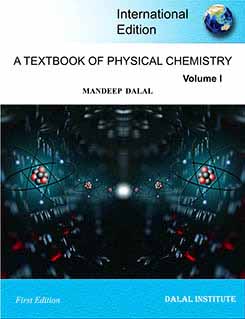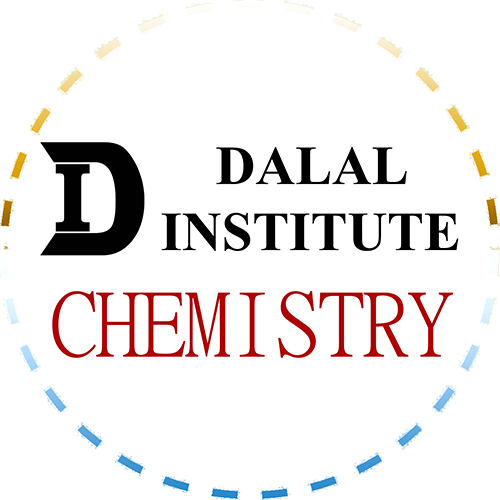
Title: A Textbook of Physical Chemistry – Volume 1
Author: Mandeep Dalal
ISBN: 8193872010, 9788193872017 (Paperback)
Publisher: Dalal Institute
Edition: First
Number of Pages: 432
Physical Dimensions: 7.44 × 9.69 inch
Buy: Amazon India / Amazon USA /Amazon UK / Amazon Canada / Amazon France / Amazon Germany / Amazon Italy / Amazon Spain / Amazon Japan / Amazon Brazil / Amazon Australia / Amazon Netherlands / Amazon Mexico
DESCRIPTION
An advanced-level textbook of physical chemistry for the graduate (B.Sc) and postgraduate (M.Sc) students of Indian and foreign universities. This book is a part of the four-volume series, entitled “A Textbook of Physical Chemistry – Volume I, II, III, IV”.
Table of Contents
- CHAPTER 1: Quantum Mechanics – I
- Postulates of Quantum Mechanics
- Derivation of Schrodinger Wave Equation
- Max-Born Interpretation of Wave Functions
- The Heisenberg’s Uncertainty Principle
- Quantum Mechanical Operators and Their Commutation Relations
- Hermitian Operators (Elementary Ideas, Quantum Mechanical Operator for Linear Momentum, Angular Momentum and Energy as Hermitian Operator)
- The Average Value of the Square of Hermitian Operators
- Commuting Operators and Uncertainty Principle (x & p; E & t)
- Schrodinger Wave Equation for a Particle in One Dimensional Box
- Evaluation of Average Position, Average Momentum and Determination of Uncertainty in Position and Momentum and Hence Heisenberg’s Uncertainty Principle
- Pictorial Representation of the Wave Equation of a Particle in One Dimensional Box and Its Influence on the Kinetic Energy of the Particle in Each Successive Quantum Level
- Lowest Energy of the Particle
- Problems
- Bibliography
- CHAPTER 2. Thermodynamics – I
- Brief Resume of First and Second Law of Thermodynamics
- Entropy Changes in Reversible and Irreversible Processes
- Variation of Entropy with Temperature, Pressure and Volume
- Entropy Concept as a Measure of Unavailable Energy and Criteria for the Spontaneity of Reaction
- Free Energy, Enthalpy Functions and Their Significance, Criteria for Spontaneity of a Process
- Partial Molar Quantities (Free Energy, Volume, Heat Concept)
- Gibb’s-Duhem Equation
- Problems
- Bibliography
- CHAPTER 3. Chemical Dynamics – I
- Effect of Temperature on Reaction Rates
- Rate Law for Opposing Reactions of Ist Order and IInd Order
- Rate law for Consecutive & Parallel Reactions of Ist Order Reactions
- Collision Theory of Reaction Rates and Its Limitations
- Steric Factor
- Activated Complex Theory
- Ionic Reactions: Single and Double Sphere Models
- Influence of Solvent and Ionic Strength
- The Comparison of Collision and Activated Complex Theory
- Problems
- Bibliography
- CHAPTER 4. Electrochemistry – I: Ion-Ion Interactions
- The Debye-Huckel Theory of Ion- Ion Interactions
- Potential and Excess Charge Density as a Function of Distance From the Central Ion
- Debye-Huckel Reciprocal Length
- Ionic Cloud and its Contribution to the Total Potential
- Debye-Huckel Limiting Law of Activity Coefficients and its Limitations
- Ion-Size Effect on Potential
- Ion-Size Parameter and the Theoretical Mean-Activity Coefficient in the Case of Ionic Clouds with Finite-Sized Ions
- Debye-Huckel-Onsager Treatment for Aqueous Solutions and Its Limitations
- Debye-Huckel-Onsager Theory for Non-Aqueous Solutions
- The Solvent Effect on the Mobility at Infinite Dilution
- Equivalent Conductivity (Λ) vs. Concentration c1/2 as a Function of the Solvent
- Effect of Ion Association upon Conductivity (Debye-Huckel-Bjerrum Equation)
- Problems
- Bibliography
- CHAPTER 5. Quantum Mechanics – II
- Schrodinger Wave Equation for a Particle in a Three Dimensional Box
- The Concept of Degeneracy Among Energy Levels for a Particle in Three Dimensional Box
- Schrodinger Wave Equation for a Linear Harmonic Oscillator & Its Solution by Polynomial Method
- Zero Point Energy of a Particle Possessing Harmonic Motion and its Consequence
- Schrodinger Wave Equation for Three Dimensional Rigid Rotator
- Energy of Rigid Rotator
- Space Quantization
- Schrodinger Wave Equation for Hydrogen Atom, Separation of Variable in Polar Spherical Coordinates and its Solution
- Principal, Azimuthal and Magnetic Quantum Numbers and the Magnitude of Their Values
- Probability Distribution Function
- Radial Distribution Function
- Shape of Atomic Orbitals (s,p & d)
- Problems
- Bibliography
- CHAPTER 6. Thermodynamics – II
- Clausius-Clapeyron Equation
- Law of Mass Action and Its Thermodynamic Derivation
- Third Law of Thermodynamics (Nernest Heat Theorem, Determination of Absolute Entropy, Unattainability of Absolute Zero) and Its Limitation
- Phase Diagram for Two Completely Miscible Components Systems
- Eutectic Systems (Calculation of Eutectic Point)
- Systems Forming Solid Compounds AxBy with Congruent and Incongruent Melting Points
- Phase Diagram and Thermodynamic Treatment of Solid Solutions
- Problems
- Bibliography
- CHAPTER 7. Chemical Dynamics – II
- Chain Reactions: Hydrogen-Bromine Reaction, Pyrolysis of Acetaldehyde, Decomposition of Ethane
- Photochemical Reactions (Hydrogen-Bromine & Hydrogen-Chlorine Reactions)
- General Treatment of Chain Reactions (Ortho-Oara Hydrogen Conversion and Hydrogen-Bromine reactions)
- Apparent Activation Energy of Chain Reactions
- Chain Length
- Rice-Herzfeld Mechanism of Organic Molecules Decomposition (Acetaldehyde)
- Branching Chain Reactions and Explosions (H2-O2 Reaction)
- Kinetics of (One Intermediate) Enzymatic Reaction: Michaelis-Menton Treatment
- Evaluation of Michaelis ‘s Constant for Enzyme-Substrate Binding by Lineweaver-Burk Plot and Eadie-Hofstae Methods
- Competitive and Non-Competitive Inhibition
- Problems
- Bibliography
- CHAPTER 8. Electrochemistry – II: Ion Transport in Solutions
- Ionic Movement Under the Influence of an Electric Field
- Mobility of Ions
- Ionic Drift Velocity and Its Relation with Current Density
- Einstein Relation Between the Absolute Mobility and Diffusion Coefficient
- The Stokes-Einstein Relation
- The Nernst-Einstein Equation
- Walden’s Rule
- The Rate-Process Approach to Ionic Migration
- The Rate Process Equation for Equivalent Conductivity
- Total Driving Force for Ionic Transport: Nernst-Planck Flux Equation
- Ionic Drift and Diffusion Potential
- The Onsager Phenomenological Equations
- The Basic Equation for the Diffusion
- Planck-Henderson Equation for the Diffusion Potential
- Problems
- Bibliography
- INDEX



